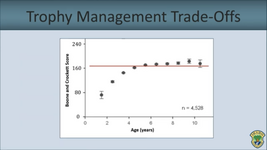There are so many variables to think about in this discussion. Different states, habitats, season timing, hunter numbers, weapons, desired age class, and the list goes on. All those factors matter and more often than not a case by case approach is needed. I push back on that a little because a unit by unit approach can lose sight of how changes in one unit affect the others. Nothing happens in a vacuum.
My intent in bringing up this video by IDFG and giving my thoughts is to ask hunters to slow down and consider multiple factors when calling for changes to mule deer management. Tag cuts and limited entry has been the answer for the last few decades and I think we should try something different. A full general season structure would not work everywhere but I think we need to understand what we give up in exchange for limited entry hunts.
The video and the two Colorado studies highlight some interesting data about the inverse relationship between D : D ratios and F : D ratios (quoted below). It is worth talking about in the context of trophy management.
The diminishing returns in terms of B&C score after age 4.5 is another thing worth talking about.
The domino effect of reducing tag numbers and the impact of displaced hunters to the quality of general seasons is worth talking about.
Natural mortality of young bucks is worth talking about.
I think a lot of current discussion about herd health is a masked discussion about trophy quality. "We have to cut tags to save the herd" I call bull-crap. Cutting buck harvest won't make more fawns hit the ground.
"Two evaluations of Colorado's harvest management decisions have occurred (Bishop et al.
2005, Bergman et al.
2011). Each of these was an evaluation of restrictions to deer hunting, and primarily within this, restrictions on the hunting of adult male deer. In each case, as harvest was restricted, an increase in adult male:adult female ratios was observed. In particular, ratios increased by as many as 4.52 adult males per 100 adult females in one study (Bishop et al.
2005) and by as many as 21.86 adult males per 100 adult females in the other study (Bergman et al.
2011). However, simultaneous declines in fawn:adult female ratios were observed as part of each study. Declines were as high as 6.96 fawns per 100 adult females (Bergman et al.
2011) and 7.51 fawns per 100 adult females (Bishop et al.
2005). While neither study was a direct experimental evaluation of intraspecific competition or density dependence,
both studies provide circumstantial evidence that increasing the proportion of adult male deer in the population came at the expense of population productivity."

